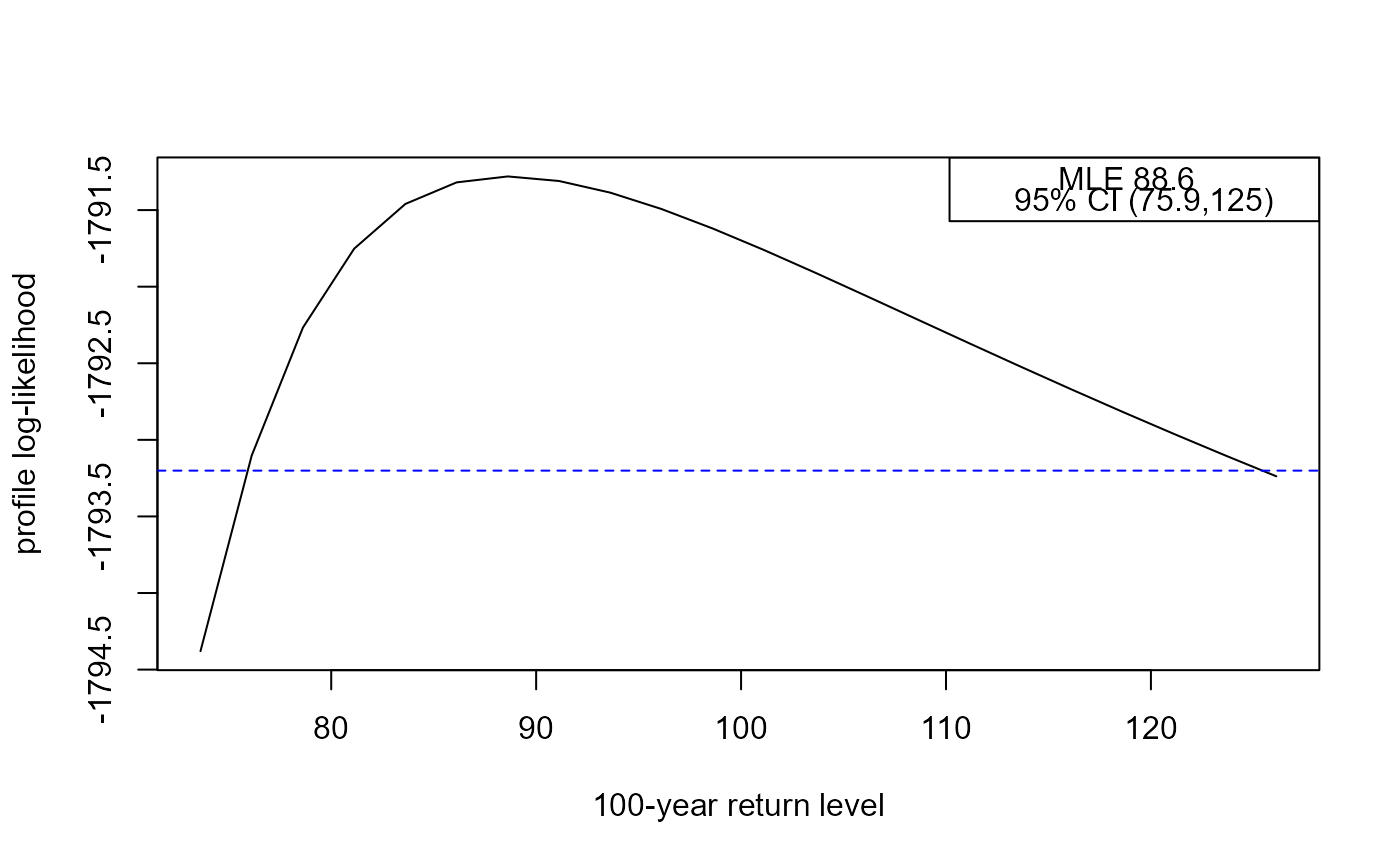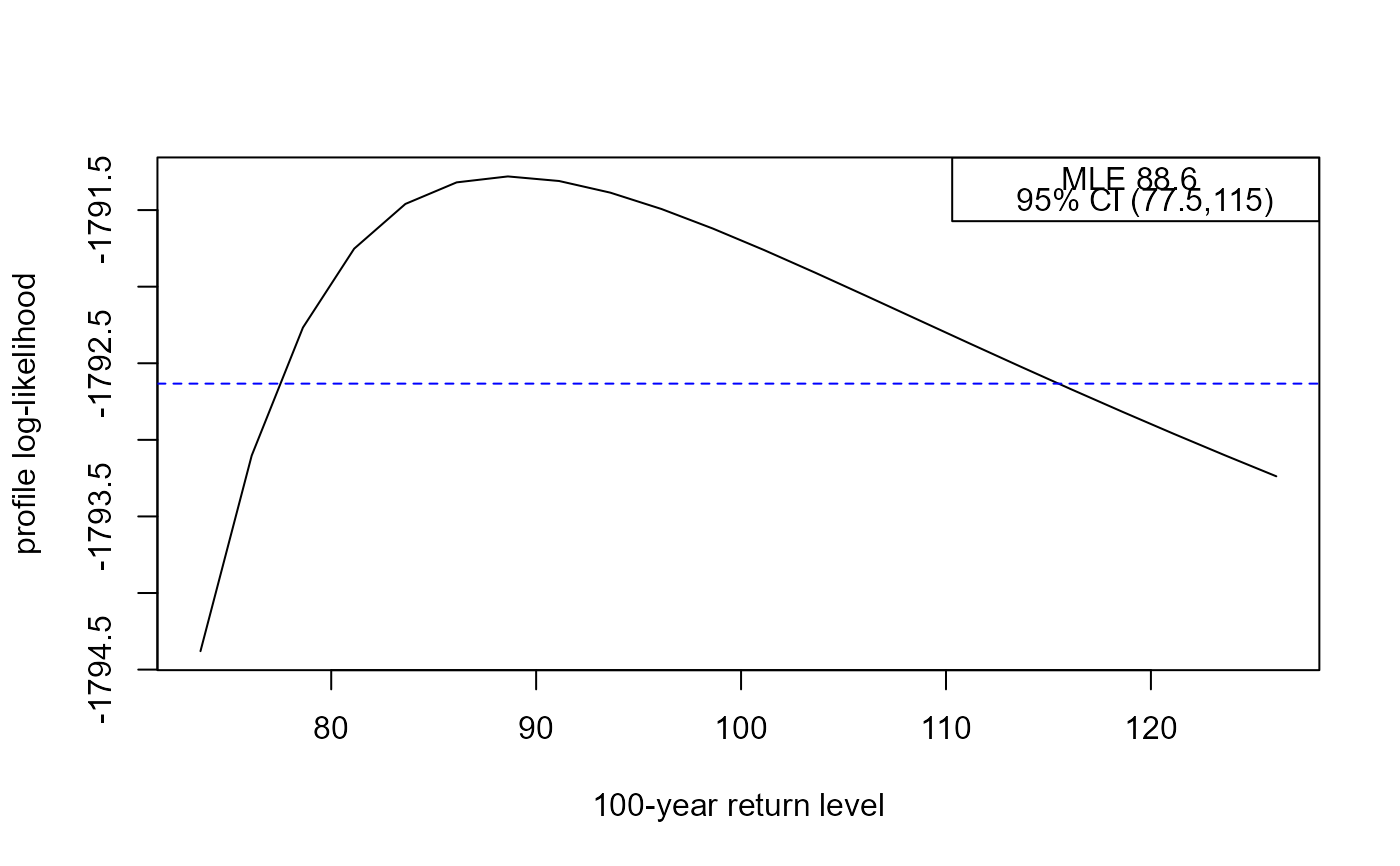Calculates point estimates and confidence intervals for m-year
return levels for stationary time series fitted extreme value model objects
returned from flite. Two types of interval may be returned:
(a) intervals based on approximate large-sample normality of the maximum
likelihood estimator for return level, which are symmetric about the point
estimate, and (b) profile likelihood-based intervals based on an (adjusted)
log-likelihood.
returnLevel(
x,
m = 100,
level = 0.95,
ny,
prof = TRUE,
inc = 1/100,
type = c("vertical", "cholesky", "spectral", "none")
)Arguments
- x
An object inheriting from class
"flite"returned fromflite.- m
A numeric scalar. The return period, in years.
- level
A numeric scalar in (0, 1). The confidence level required for confidence interval for the
m-year return level.- ny
A numeric scalar. The (mean) number of observations per year. Setting this appropriately is important. See Details.
- prof
A logical scalar. Should we calculate intervals based on profile log-likelihood?
- inc
A numeric scalar in (0, 1/2]. Only relevant if
prof = TRUE. The increment, a fraction of the length of the symmetric confidence interval for them-year return level, by which we move upwards and downwards from the MLE for the return level in the search for the lower and upper confidence limits.- type
A character scalar. The argument
typeto the function returned by the functionadjust_loglik, that is, the type of adjustment made to the independence log-likelihood function in creating an adjusted log-likelihood function. See Details and Value inadjust_loglik.
Value
A object (a list) of class "returnLevel", "lite" with the
components
- rl_sym,rl_prof
Named numeric vectors containing the respective lower 100
level% limit, the MLE and the upper 100level% limit for the return level. Ifprof = FALSEthenrl_profwill be missing.- rl_se
Estimated standard error of the return level.
- max_loglik,crit,for_plot
If
prof = TRUEthen these components will be present, containing respectively: the maximised log-likelihood; the critical value and a matrix with return levels in the first column (ret_levs) and the corresponding values of the (adjusted) profile log-likelihood (prof_loglik).- m,level
The input values of
mandlevel.- ny
The value of
nyused to infer the return level.- call
The call to
returnLevel.
Details
For information about return levels see the "Introducing lite" vignette.
ny provides information about the (intended) frequency of
sampling in time, that is, the number of observations that would be
observed in a year if there are no missing values. If the number of
observations may vary between years then ny should be set equal to
the mean number of observations per year.
Supplying ny.
The value of ny may have been set in the call to
flite. If ny is supplied by the user in the call to
returnLevel then this will be used in preference to the value
stored in the fitted model object. If these two values differ then no
warning will be given.
For details of the definition and estimation of return levels see the Inference for return levels vignette.
The profile likelihood-based intervals are calculated by
reparameterising in terms of the m-year return level and estimating
the values at which the (adjusted) profile log-likelihood reaches
the critical value logLik(x) - 0.5 * stats::qchisq(level, 1).
This is achieved by calculating the profile log-likelihood for a sequence
of values of this return level as governed by inc. Once the profile
log-likelihood drops below the critical value the lower and upper limits
are estimated by interpolating linearly between the cases lying either
side of the critical value. The smaller inc the more accurate (but
slower) the calculation will be.
References
Coles, S. G. (2001) An Introduction to Statistical Modeling of Extreme Values, Springer-Verlag, London. doi:10.1007/978-1-4471-3675-0_3
See also
returnLevelMethods, including plotting the (adjusted)
profile log-likelihood for a return level.
Examples
### Cheeseboro wind gusts
# Make inferences
cdata <- exdex::cheeseboro
# Each column of the matrix cdata corresponds to data from a different year
# flite() sets cluster automatically to correspond to column (year)
cfit <- flite(cdata, u = 45, k = 3)
# These data are hourly for one month (January) year so ny = 31 * 24
# Large inc set here for speed, sacrificing accuracy
# Default 95% confidence intervals
rl <- returnLevel(cfit, inc = 1 / 10, ny = 31 * 24)
summary(rl)
#>
#> Call:
#> returnLevel(x = cfit, ny = 31 * 24, inc = 1/10)
#>
#> Estimate Std. Error
#> m = 100 88.61986 9.600889
rl
#>
#> Call:
#> returnLevel(x = cfit, ny = 31 * 24, inc = 1/10)
#>
#> MLE and 95% confidence limits for the 100-year return level
#>
#> Normal interval:
#> lower mle upper
#> 69.80 88.62 107.44
#> Profile likelihood-based interval:
#> lower mle upper
#> 76.15 88.62 125.45
oldrl <- plot(rl)
 oldrl
#> lower mle upper
#> 76.15487 88.61986 125.44775
# Quickly recalculate/replot the intervals based on profile log-likelihood
# provided that level is smaller than that used to produce rl
newrl <- plot(rl, level = 0.9)
oldrl
#> lower mle upper
#> 76.15487 88.61986 125.44775
# Quickly recalculate/replot the intervals based on profile log-likelihood
# provided that level is smaller than that used to produce rl
newrl <- plot(rl, level = 0.9)
 newrl
#> lower mle upper
#> 77.40536 88.61986 115.49662
newrl
#> lower mle upper
#> 77.40536 88.61986 115.49662